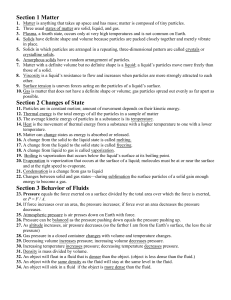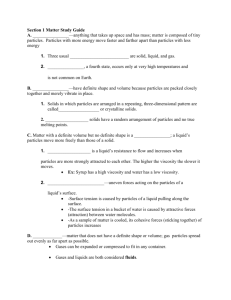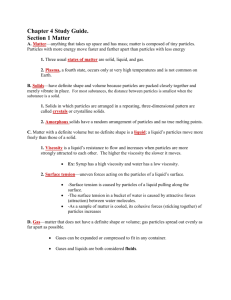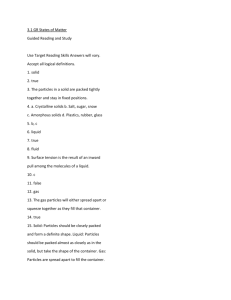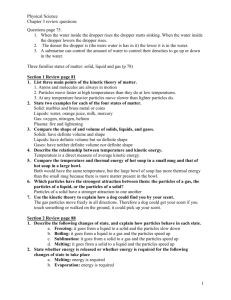Ch. 14 Notes
advertisement
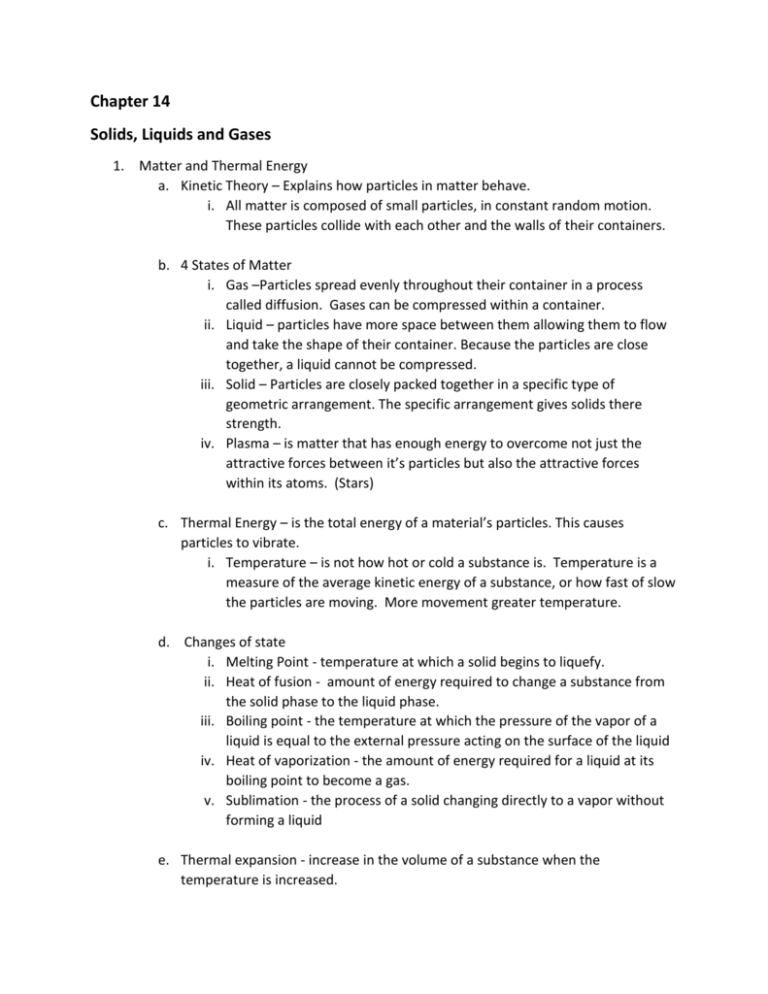
Chapter 14 Solids, Liquids and Gases 1. Matter and Thermal Energy a. Kinetic Theory – Explains how particles in matter behave. i. All matter is composed of small particles, in constant random motion. These particles collide with each other and the walls of their containers. b. 4 States of Matter i. Gas –Particles spread evenly throughout their container in a process called diffusion. Gases can be compressed within a container. ii. Liquid – particles have more space between them allowing them to flow and take the shape of their container. Because the particles are close together, a liquid cannot be compressed. iii. Solid – Particles are closely packed together in a specific type of geometric arrangement. The specific arrangement gives solids there strength. iv. Plasma – is matter that has enough energy to overcome not just the attractive forces between it’s particles but also the attractive forces within its atoms. (Stars) c. Thermal Energy – is the total energy of a material’s particles. This causes particles to vibrate. i. Temperature – is not how hot or cold a substance is. Temperature is a measure of the average kinetic energy of a substance, or how fast of slow the particles are moving. More movement greater temperature. d. Changes of state i. Melting Point - temperature at which a solid begins to liquefy. ii. Heat of fusion - amount of energy required to change a substance from the solid phase to the liquid phase. iii. Boiling point - the temperature at which the pressure of the vapor of a liquid is equal to the external pressure acting on the surface of the liquid iv. Heat of vaporization - the amount of energy required for a liquid at its boiling point to become a gas. v. Sublimation - the process of a solid changing directly to a vapor without forming a liquid e. Thermal expansion - increase in the volume of a substance when the temperature is increased. 2. Properties of Fluids a. Archimedes’ Principle – Buoyant force on an object is equal to the weight of the fluid displaced by the object. b. Buoyancy - ability of a fluid, which include liquids and gases, to exert an upward force on an object immersed in it. i. An object in a fluid will float if its weight is less than the buoyant force acting on it from the fluid. ii. An object in a fluid will sink if its weight is more than the buoyant force acting on it from the fluid. iii. An object will float if its density is less than the density of the fluid it is placed in. iv. Density = mass / volume on object will float if its density is less than that of the fluid it is being placed in. c. Pascal’s Principal – Pressure applied to a fluid is transmitted throughout the fluid. i. Pressure is force exerted per unit area. ii. Hydraulic machines use this principle to lift heavy loads (The Blob at the lake) d. Bernoullli’s principle – as the velocity of a fluid increases, the pressure exerted by the fluid decreases: airplanes use this principle to fly. e. Viscosity - a fluid's resistance to flowing. 3. Behavior of Gases a. Pressure – is measured in units called pascal (Pa) i. Collisions of particles in air result in atmospheric pressure. ii. Moving particles colliding with the inside walls of a container result in gas pressure. b. Boyle’s Law – relates pressure and volume i. Volume decreases as pressure increases. ii. Pressure decreases as volume increases. iii. Pressure multiplied by volume is always equal to a constant if the temperature is constant. c. Charles’s Law – relates volume and temperature i. At a constant pressure, volume increases as temperature increases. ii. At a constant pressure volume decreases as temperature decreases. Ch 14 Vocabulary Boiling point - the temperature at which the pressure of the vapor of a liquid is equal to the external pressure acting on the surface of the liquid Boyle's law - states that the volume and pressure of a gas are related, such that if the temperature of a gas remains constant, an increase in volume causes a proportional decrease in the pressure Buoyancy - ability of a fluid, which include liquids and gases, to exert an upward force on an object immersed in it Charles's law - states that the temperature and volume of a gas are related such that, if the pressure is constant, an increase in temperature will produce a proportionate increase in the volume Heat of fusion - amount of energy required to change a substance from the solid phase to the liquid phase Heat of vaporization - the amount of energy required for a liquid at its boiling point to become a gas Kinetic theory - explanation of the behavior of particles in gases; states that matter is made of constantly moving particles that collide without losing energy Melting point - temperature at which a solid begins to liquefy Pascal - SI unit of pressure Plasma - matter with enough energy to overcome the attractive forces within its atoms, composed of positively and negatively charged particles Pressure - amount of force exerted per unit area; SI unit is the pascal (Pa) Sublimation - the process of a solid changing directly to a vapor without forming a liquid Thermal expansion - increase in the volume of a substance when the temperature is increased Viscosity - a fluid's resistance to flowing



